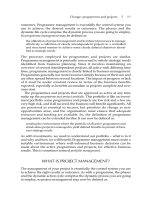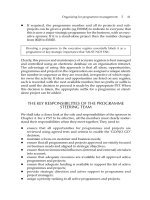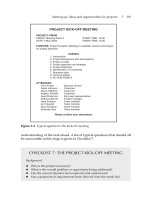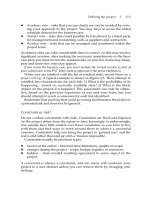50 little things that make a big difference to team motivation and leadership phần 2 pdf
Bạn đang xem bản rút gọn của tài liệu. Xem và tải ngay bản đầy đủ của tài liệu tại đây (681.48 KB, 13 trang )
THE PREMIER DIVISION
A great boss will tell you, “It’s all about people.” A bad boss will say,
“It’s all about money.”
As Confucius said, “The gold in your heart is more precious than the
gold in your purse.” The best team leaders devote their working lives to
helping people discover the gold in their hearts and allowing it to shine
on others. We all become richer that way.
There are 12 little things that the best team leaders do in getting
started on doing the biz. These make up the premier division of
essential behaviors for team leadership and motivation. If you practice
these, you will be well on the road to having a high-performing team.
1 Make people your top priority
2 Be an exemplar
3 Give cause (aspire)
4 Hire the best
5 Fight to pay the best
6 Personalize relationships
7 Liberate people with trust
8 Communicate immediately
9 Initiate learning
10 Know what you want to be
11 Agree the contribution to be made
12 Measure what is important
Biz 1-12 3/8/04 7:58 PM Page 5
6
MAKE PEOPLE YOUR TOP PRIORITY
Always put your people first in allocating your
time and deciding on your agenda.
The most important little thing you can do is give time to your people
and thus demonstrate that they have top priority. The odd minute, the
half-hour chat, and the occasional relaxed hour with them are critical if
you are going to motivate people to do the biz.
Giving top priority to team members requires you to drop
everything for them in times of need. Nothing is more important for the
biz. Furthermore, in order for you to motivate team members they
need to know the value you place on them and how critical you see
their contribution as being. They need to know that their team leader is
interested in their work and would rather devote time to supporting
them than doing other things.
78 high-priority minutes
✪ One minute looking at Fernando’s new car.
✪ Two minutes joking with Eddie about the football.
✪ Three minutes hearing about Jamil’s sister’s wedding.
✪ Four minutes reviewing with Ayshath her project report.
✪ Five minutes listening to Andrew’s account of his meeting.
✪ Six minutes advising Carlton on his budget figures and plans.
✪ Seven minutes congratulating Mercedes on her sales success.
✪ Eight minutes counseling Colette on her relationship problems.
✪ Nine minutes discussing Jackie’s proposed update for the website.
✪ Ten minutes with Ann helping her rehearse a presentation to the CEO.
✪ Eleven minutes’ follow-up with Beatrice concerning her transfer request.
✪ Twelve minutes on a team meeting to update people on last week’s results.
When team leaders fail to find time for people and assign them low
priority, those people begin to feel neglected and make assumptions that
their leaders don’t care and are not interested in their work or problems.
While no boss can be on site every day, it is essential that you set time
aside in your diary for wandering around and chatting to people. A boss’s
diary should never be so full that there is no time for other people.
Biz 1-12 3/8/04 7:58 PM Page 6
7
The intention of giving high priority to spending time with team
members is not to communicate key messages but to learn what is
going on in people’s lives and at work. Excellent team leaders will be
keen to learn what has been happening in
employees’ day-to-day routines: the
exceptions, the problems, the
successes, and the stories. They will
want to increase their understanding
of people’s work situations and their
specific needs, whether it be addressing
a problem with a malfunctioning piece of
equipment or dealing with an issue relating to a particularly troublesome
customer. In this way leaders can assign top priority to helping team
members resolve their problems at work.
When an issue does arise they will stop at nothing to get it resolved.
Where appropriate they will chase head office for a resolution. They will
also ensure that people issues are at the top of the agenda for meetings
with their own senior executive and the head office team. The last thing
these bosses will do is allow issues to fester.
To prevent this happening, good team leaders will assign a high
priority to sitting down with each team member for a regular informal
chat about “the story so far.” They will update individuals and the team
on progress and demonstrate the importance they are giving to getting
specific problems resolved.
On the rare occasions when a big issue blows up or an incident
occurs, these bosses will drop everything to help their team. They will
walk out of meetings, cancel travel plans, and automatically place the
highest emphasis on joining the team to help them solve the problem.
THE BIZ STEP 1
Ask your team straight: Do I assign a sufficiently high priority to
providing the support you need?
BIZ POINT
A reflection of what you value in life is not how you spend
your money, but how you spend your time and the priorities
you set.
Biz 1-12 3/8/04 7:58 PM Page 7
BE AN EXEMPLAR
Set the best example with every little thing
you do and say.
Every little thing you do has a positive, negative, or neutral impact on your
team’s motivation. There is no avoiding it. As a boss you are under
observation all the time—even when people can’t see you. In fact, those
bosses who are rarely seen are the worst examples of all, failing to support
the team in times of need. Not that you have to be there all the time
interfering with everything going on—that would be a bad example too.
You set the standard of behavior that the team will emulate. It is the
same with values. They don’t need to be written down or even debated
at length—your values are reflected in everything you do and as such are
an example of the values that your team will strive to adopt and exceed
to please you.
The best team leaders are exemplars of:
✔ Punctuality (they are always on time).
✔ Volunteering (they offer to help when the workload is high).
✔ Charm (they are hospitable and welcome all visitors warmly).
✔ Openness and honesty (they are completely trusted by everyone).
✔ Courtesy (they always treat others with respect and are well-mannered).
✔ Equality (they fetch the tea for everyone and treat everyone the same).
✔ Listening (they are not opinionated and will give full attention to what people say).
✔ Hard work (they never skive off or take it easy when the team is hard-pressed).
✔ Positive thinking (they are never negative, never complain or speak badly of others).
✔ Precision in paperwork (they make few mistakes, their facts and figures are perfect, and their
presentation is excellent).
✔ Decisiveness (they know how to make decisions and when to leave a decision to the team).
Team leaders are living examples of the expectations to be exceeded, of
the excellence to be adopted, of the imperfections to be forgiven and
the lessons to be learnt. The way bosses talk to customers will set a
standard by which their team will judge them. If their standards are low,
the example will be bad and the team will judge them accordingly. If
their standards are high, the team will attempt to emulate their practice
8
Biz 1-12 3/8/04 7:58 PM Page 8
of excellence. This applies equally to the concisely written word, the
prompt response to emails, the warm tone adopted in taking a call, and
the clarity of presentations.
The way team leaders speak to team members is an example of the
way they think and feel about their team. It is an example of their own
personality.
The example bosses set should never be static,
to be repeated day in and day out. Like any good
thing it can be improved on by pushing back the
boundaries. There is always a better way and
excellent team leaders set an example by striving
to find the best approach to be adopted and
followed. There might just be a better way of
engaging customers, of communicating with
suppliers, of behaving with the board, of
inspiring the team, and of spending time.
Leaders are always in pursuit of the best.
Encouragement, celebration, praise, punishment,
and the odd remark and scathing comment are all aspects that can
either enthuse or infect a team. Motivation is a product of the minutest
of examples set by bosses first thing on a Monday morning and last thing
on a Friday evening. It is a product of who team leaders speak to (and
who they don’t) and what they do throughout the week.
The emperor might wear no clothes, but the people will see him for
what he is—and that is the standard for good or bad by which
judgments about the boss are made. There is no escaping everyday
reality. The example cannot be written down. It has to be practiced—in
fact, it is everything practiced by team leaders.
THE BIZ STEP 2
Become conscious every day of the example you set and
then set out to become an exemplar of all that is best in your
business. That’s the biz.
BIZ POINT
As a boss you are an exemplar whether you like it or
not. The question is: Do you exemplify the best?
9
Biz 1-12 3/8/04 7:58 PM Page 9
GIVE CAUSE (ASPIRE)
Give cause to everything you and the team do.
Aspiration is the source of all motivation.
One little thing effective team leaders need to do is to clarify where
they are taking the business in the medium to long term. The
fashionable word for this is “vision” (termed “biz vis” in this book).
Two other ways of expressing the “biz vis” are “cause” and
“aspiration.” An effective business has a leadership cause together with an
aspiration to achieve it. The two are linked, as it takes spirit to pursue a
cause. It thus becomes our aspiration (a word that relates to the direction
of the spirit). Nelson Mandela had both an aspiration and a cause: to end
apartheid and unify South Africa. It motivated a whole nation—now they
are doing the biz and the economy is
growing. Walt Disney had an aspiration and a
cause: to create happiness through fun
characters, films, cartoons, and theme parks.
Everyone can relate to these causes because
they relate to their own personal beliefs and
aspirations about the best way forward for
today, tomorrow, and next year. The belief
(in the cause) and the aspiration are vested
in a person’s soul and stimulate the spiritual energies that drive behavior.
All the little things team leaders say and do should reflect the
aspirational cause they hold for the business. When this is articulated in
a simple and meaningful way, people can identify with it. This will spark
their own spirit and motivational energies to support and contribute in
moving toward the biz vis.
The word “because” is useful here as it leads us to what will “be”
the “cause.” Thus a good test for finding the source of motivation is to
complete the sentence: “We do this because…” If the completed
statement is clear, succinct, and acceptable, the probability is that the
team leader has a good cause that will encourage the team’s spiritual
and emotional energies to move forward.
Cause is related to reason, motivation, and answering the question:
“Why do we do this?” For example, you might ask: “Why are our
10
Biz 1-12 3/8/04 7:58 PM Page 10
absentee levels increasing?” The word “because” will lead you to the
answer.
A study of any well-known leader will reveal a cause. Churchill had a
cause (so did Hitler, for that matter). Jack Welch had a cause: to be
number one in each of General Electric’s business segments. Michael
Dell had a cause: to find a better way of making and distributing
computers and thus reduce their price for customers. In the 1980s Sir
Colin Marshall’s cause for British Airways was for it to become the
world’s favorite airline.
However, the cause cannot be created only by the icons at the top
of the organization. While a high-level strategic cause is essential, there
needs to be an operational cause for every team leader—and every
individual. In a perfect world all three causes (strategic, team, and
individual) should be intrinsically interwoven.
Examples of a team leader’s operational cause might be:
✪ As a team we will buzz because we want every customer to be satisfied with what we do for them.
✪ As a call center we will respond efficiently, effectively, and with empathy to our customers because
we want every customer to have a good memory of us.
✪ As a team of technicians we will develop our expertise because we want our customers’ problems
to be fixed quickly and finally.
✪ As a team of engineers we are going to work flat out this weekend because we want this technical
problem to be solved.
✪ As a sales team we are going to improve our approach to customers because we need to generate
more revenue.
THE BIZ STEP 3
Take one little step today and clarify your team’s cause.
Keep asking yourself and the team: “Why?” and “Why do we
do this?”
Use the word “because” to help you provide an answer. If you
cannot believe in the answer and it does not align with your
aspiration, then reconsider your work and your approach to it.
BIZ POINT
Ideally, the soul of an individual, of a team, and of an
organization should be centered on a cause (the belief
and the aspiration). That’s the biz vis.
11
Biz 1-12 3/8/04 7:58 PM Page 11
HIRE THE BEST
The best people to hire are those who are
motivated to be the best in their chosen field.
The biz starts at the beginning: unless you hire the best people you will
be in trouble for many months if not years to come. When you hire
second- or third-rate people you lock yourself into
performance troubles and you will waste time trying
to extricate the company from all the problems that
these laggards create. Poor performers are time
wasters. They waste everyone’s time with the problems
they cause.
When you hire people, one little thing you should do that
will make a big difference is to look for their motivation.
This will be reflected in:
The best track record The candidate is motivated to achieve great results.
The best skills/talents The candidate has a high degree of self-awareness and is motivated
to focus on and develop what he or she is best at in life and at work.
The best experience The candidate is motivated to develop his or her career by gaining
new experiences.
The best knowledge The candidate is motivated to learn and become an expert in his or
her chosen field.
The best behavior The candidate is motivated to create the best personal approach.
The best relationship skills The candidate is motivated to work well with people.
The best potential The candidate is ambitious and is motivated to do even better than
in the past.
The best energy levels The candidate is motivated to work hard to achieve personal goals
at work.
The best attitude The candidate is motivated to be positive, helpful, and a good team
member.
The best imagination The candidate is motivated to find creative ways of overcoming
problems and creating a bright new future for the team and the
company.
The best qualifications The candidate is motivated to demonstrate formally, through
qualifications, that he or she is exceptionally well educated.
12
Biz 1-12 3/8/04 7:58 PM Page 12
The best employers The candidate is motivated to work for only the best employers.
The best pay The candidate sees pay as a barometer of success and therefore has
always been paid the best.
These factors apply whether you are hiring a chief executive or a bus
driver. For example, it is far better to hire a bus driver who
is motivated to have the best safety record
and to learn about customer
service than to hire a bus
driver who is merely there to
earn money by driving a bus
from A to B.
It can often be a struggle to
find the best. Even if the market is tight, this is no reason for selecting
second best. There are many enlightened and progressive executives
who, on encountering a person who is the best, will hire them
irrespective of whether or not there is a job vacancy. When you find the
best people, hire them immediately.
If you want to do the biz and the best for your employees,
customers, company, and shareholders, then you have no option but to
recruit the best people. Anyone else will drag the company down.
This means that for every little step of the way in the recruitment
and selection process, you have to qualify each decision with the word
“best”—the best advertisement, the best selection methodology, the
best interviewers, and the best candidates.
THE BIZ STEP 4
When it is time to fill the next job vacancy, apply the word
“best” to the first step in the process and every step thereafter.
BIZ POINT
Your company can only be as good as the people you
recruit.
13
Biz 1-12 3/8/04 7:58 PM Page 13
FIGHT TO PAY THE BEST
If someone leaves your employ for better pay,
you have failed. If you don’t pay the best,
someone else will and you won’t be the best.
The underpinning philosophy of all the practices specified in this book is
that for your team members to do the best, the team leader has to do
the best for them. An intrinsic part of doing the best relates to pay.
One little but very important thing you can do for your team is to fight
to get them the best pay possible within the budgetary constraints of
the business.
People are not commodities to be traded on the shopfloor for the
lowest possible price. As a strategic policy the pursuit of the cheapest
source of labor is a policy that will bring disaster to a company in the
long term.
An assertion such as “people are our greatest asset” is meaningless
unless you take all the little steps necessary to pay the best. When times
are tough and revenues decline, it is your best people who are going to
get you out of the trough. If you drive these best people away by
reducing their pay, you will be doomed.
The best people command the best pay and they will travel to
wherever they can find it. Quality, motivation, and business performance
will suffer as soon as people realize that they could be better off
working elsewhere.
If you want the best for your customers and your company in a very
competitive marketplace, there is no other logic than the following:
To get the best results
You must have the best people
To hire and retain the best people
You must give them the best pay
There is nothing new about this. There is an ancient adage of immense
wisdom that states: “Pay peanuts, get monkeys.”
14
Biz 1-12 3/8/04 7:58 PM Page 14
Most people want the best for themselves,
their families, and hopefully their
communities. It is the prerogative of every
employee—not of their employer—to
determine what the best means to them.
Eight key motivational drivers for most
people are that:
✪ They can feed their family.
✪ They have a roof over their head.
✪ Their children receive the best education possible.
✪ They are healthy and have the best medical provision when necessary.
✪ They can enjoy their leisure and vacation time with new stimuli.
✪ They do work that interests them and that they feel makes a contribution.
✪ They can improve themselves.
✪ They can do good for their community.
What is perceived to be the best is relative to the market and has to
take into account other benefits that your employees value. However, in
the end it is employees who decide what they believe is the best.
As a boss, therefore, you have no other option but to aim to be the
best in the marketplace in paying your employees the best.
THE BIZ STEP 5
You cannot afford for any one of your employees to feel bad
because of low pay. This puts the company at risk.
Find out now how your team members feel and take action to
ensure that everyone is paid the best in the circumstances that
prevail. Then ensure that your employees give of their best.
BIZ POINT
What you pay your shareholders is determined by what
you pay your employees—the more the merrier in both
cases.
15
Biz 1-12 3/8/04 7:58 PM Page 15
PERSONALIZE RELATIONSHIPS
You cannot motivate your team unless you
treat each individual as a human being. This
means personalizing your relationship with
each one.
You can call it whatever you like, employee relations or labor relations,
but in the end it is all about relationships. Successful business is built on
motivated relationships and one essential stream of relationships is
between team leaders and their teams. When these fail the business
stops. Where there is a trade union this means a strike and employees
walk out. In a non-unionized company the same applies—when
relationships fail employees walk away to work elsewhere.
To do the biz, team leaders need to discover a whole world of little
personal things about each team member and thus build a relationship
based on mutual personal interest. For example:
BEING PERSONAL
❖ How did Vijay’s best friend’s party go?
❖ What does Asha like to do at weekends?
❖ Has Lauren completed her studies yet?
❖ Has Edward’s court case come up yet?
❖ How did Nancy’s hospital visit go?
❖ How are Tariq’s elderly parents?
❖ Why is Samuel looking so grim?
❖ What does Kesh really want?
❖ Why is Kenny so often annoyed?
❖ Where is Cheng Min going on
vacation?
❖ What are Nora’s interests outside work?
❖ When will Michael’s graduation take place?
❖ What does Faye think of the latest blockbuster film?
❖ Can I see the photos of Gladys’s grandchildren? Here are some photos of my kids.
Being personal is synonymous with treating each employee as a genuine
human being. It means appreciating what makes them tick, what annoys
16
Biz 1-12 3/8/04 7:58 PM Page 16
them, what makes them feel good, and what makes them come to work
every day. It means knowing something about their family as well as about
their interests outside work. It means striving to
understand the total person and doing your best to
help that person accomplish his or her goals at
work.
Being personal leads to a high degree of
motivation. The converse, a totally impersonal
approach, inevitably leads to demotivation.
Furthermore, being personal is a two-way process
that involves revealing some personal aspects about yourself to team
members. This helps create the necessary emotional connections and
demonstrates that you too are a human being with a heart.
Inevitably there are boundaries. Personalizing relationships with team
members is not synonymous with becoming intimate or even close to
them. What it means is discovering innocuous areas of common interest
within which a personal relationship can be grounded and built.
One chief executive I knew who led a major financial institution
would always take a written note of people’s names and what key points
they told him. The next time he visited the location he would check his
notes beforehand, thus enabling him to recall the name of the
receptionist, Christine, and that she had two daughters called Sophie and
Debbie.
Personalizing relationships is easy. All you have to do is forget about
work for a few minutes and remember that you are dealing with real
people who have real interests outside work—and then make that
personal connection.
THE BIZ STEP 6
Every day take one little step toward building personal
relationships with your team members, for example by taking an
interest in what they do outside work.
BIZ POINT
To win people’s hearts and minds you have to create
personal relationships with them. It is not intellectual
but an emotional process that comes from your heart.
17
Biz 1-12 3/8/04 7:58 PM Page 17









